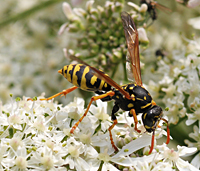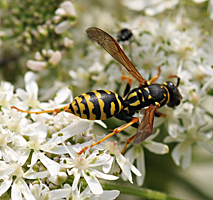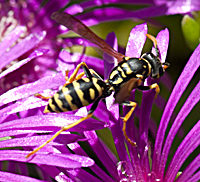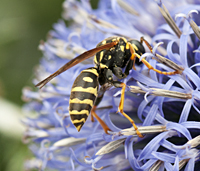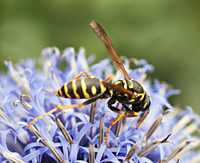[All pictures of garden wildlife on this page are thumbnails. Click on any thumbnail for a large format to be displayed.]
European Paper Wasp or Dominulus Paper Wasp (Polistes dominula)
The invasive species in the Netherlands, Dominulus Paper Wasp, has become more and more common.
Polistes dominula is a member the Vespidae family, the Social Wasps that live in small communities. Unlike other True Wasps wasps they is not attracted to the limonade and desserts in our garden but they are rather more intrested in hunting for other insects. Dominulus Paper Wasps live in Europe, North-Africa and Asia as far as Japan. The oldest records of rare occurences of them in the Netherlands date back to the late 60-ties of the past century. They belong to the subfamily of Field Wasps (Polistinae) and can be reltively easily distinguished by a slow flight with rear legs pointing backwards. The middle section of the body is strikingly narrow compared to, for instance, the German Wasp. The good news is that Field Wasps are rather reluctant to sting and even if they do so, which happens only in defence, the sting gives more of the burning than painful sensation.
European Paper Wasp or Dominulus Paper Wasp (Polistes dominula)
Like other Social Wasps, the queen of Polistes dominula establishes the nest in the spring. The nest is built from paperlike substance produced from wood and plants mixed with the saliva. The nest has an open construction in which the Paper Wasps can be seen. They feed on nectar from flowers and aphids but they also catch other insects like larvae, some beetles and shieldbugs and - unfortunately - on smaller butterflies, which they feed to their larvae.

© Copyright 1998-2024 gardensafari.net (Hania Berdys)

 English / engels
English / engels  Dutch / nederlands
Dutch / nederlands